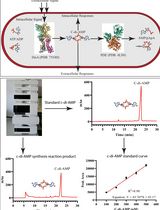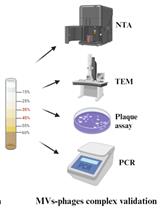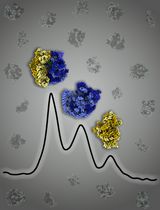- EN - English
- CN - 中文
Separating Inner and Outer Membranes of Escherichia coli by EDTA-free Sucrose Gradient Centrifugation
通过无 EDTA 蔗糖梯度离心法分离大肠杆菌的内膜和外膜
发布: 2023年03月20日第13卷第6期 DOI: 10.21769/BioProtoc.4638 浏览次数: 2516
评审: David PaulJose Antonio Reyes-DariasAnonymous reviewer(s)

相关实验方案

基于高效液相色谱法的史氏分枝杆菌DisA环二腺苷酸(C-di-AMP)合成酶活性研究
Avisek Mahapa [...] Dipankar Chatterji
2024年12月20日 1436 阅读
Abstract
The envelope of Gram-negative bacteria consists of an outer membrane (OM), a peptidoglycan cell wall, and an inner membrane (IM). The OM and IM have different components of proteins and lipids. Separating the IM and OM is a basic biochemical procedure to further study lipids and membrane proteins in different locations. Sucrose gradient ultracentrifugation of lysozyme/EDTA-treated total membrane is the most widely used method to separate the IM and OM of Gram-negative bacteria. However, EDTA is often harmful to protein structure and function. Here, we describe a relatively simple sucrose gradient ultracentrifugation method to separate the IM and OM of Escherichia coli. In this method, the cells are broken by a high-pressure microfluidizer, and the total cell membrane is collected by ultracentrifugation. The IM and OM are then separated on a sucrose gradient. Because EDTA is not used, this method is beneficial for subsequent membrane protein purification and functional study.
Background
Gram-negative bacteria are characterized by three layers of cell envelope: an outer membrane (OM), a peptidoglycan cell wall, and an inner membrane (IM) (Silhavy et al., 2010). The IM is a phospholipid bilayer consisting of glycerophospholipids like most plasma membranes, while the OM has an asymmetric lipid structure, with phospholipids in the periplasmic leaflet and lipopolysaccharides (LPS) on the cell surface (Funahara and Nikaido, 1980). Besides the difference in lipid components, the IM and OM also have different membrane protein components (Silhavy et al., 2010). The distinct components bestow their specialized functions: the IM plays a major role in active transport, while the OM protects the cell against harmful compounds like enzymes and large antibiotics and also prevents the leaking of proteins from periplasmic space (DiRienzo et al., 1978).
Separating the IM and OM helps to decipher the location and functions of proteins and lipids in the cell (Schnaitman, 1970) and can also provide the first step in membrane protein purification using styrene-maleic acid (Shu and Mi, 2022). Sucrose gradient ultracentrifugation is the most widely used method to separate the IM and OM of Gram-negative bacteria (Miura and Mizushima, 1968; Osborn et al., 1972a and 1972b; Cian et al., 2020). Lysozyme/EDTA (ethylenediaminetetraacetic acid) is used in those methods to treat the bacterial cells, in which EDTA sequesters divalent cations, thus disrupting the lateral electrostatic bridging interactions between adjacent LPS molecules (Nikaido, 1976). However, the chelating of cations by EDTA may affect the functions or structures of some membrane proteins, which need divalent cations, such as Ca2+, Mg2+, or Zn2+, to stabilize tertiary structure or/and keep activities. Here, we describe a relatively simple sucrose gradient ultracentrifugation method to separate the IM and OM of Escherichia coli, the extensively studied model organism of Gram-negative bacteria. In this method, lysozyme or EDTA are not used, so it is beneficial for subsequent membrane protein purification. To further test the purity of separated OM and IM, anti-OM (e.g., OmpC) and anti-IM proteins (e.g., AcrB) western blot can be used (Guzman-Flores et al., 2017).
Materials and Reagents
125 mL flask (PYREX, catalog number: 4980)
2,800 mL flask (PYREX, catalog number: 4420)
Pipette tips
Serological pipets
1 L centrifuge bottle (Thermo Scientific, NalgeneTM, catalog number: 3141-1006)
70 mL ultracentrifuge bottle (Beckman Coulter, catalog number: 355622)
37 mL ultracentrifuge tube (Beckman Coulter, catalog number: 344058)
Tissue grinder (DWK Life Sciences, catalog number: 8853030040)
Luria broth (Research Products International, catalog number: L24400-5000.0)
Terrific broth (Research Products International, catalog number: T15100-5000.0)
Agar (BD, BactoTM, catalog number: 214010)
Tris (American Bio, catalog number: AB02000-05000)
Sodium chloride (NaCl) (Dot Scientific, catalog number: DSS23020-5000)
Glycerol (J.T. Baker, catalog number: 2136-03)
Kanamycin sulfate (American Bio, catalog number: AB01100-00010)
Spectinomycin (Research Products International, catalog number: S23000-25.0)
Chloramphenicol (Sigma, catalog number: C0378-25G)
Sucrose (Sigma-Aldrich, catalog number: S0389-1 KG)
IPTG (isopropyl β-d-1-thiogalactopyranoside) (American Bio, catalog number: AB00841-00010)
PMSF (phenylmethylsulfonyl fluoride) (Dot Scientific, catalog number: DSP20270-25)
2-Mercaptoethanol (Sigma-Aldrich, catalog number: M6250-100ML)
Glycerol stock of BL21 (DE3) star plysS strain expressing the YejM/LapB complex (Shu and Mi, 2022)
Hydrochloric acid (J.T. Baker, catalog number: 9535-00)
LB medium (see Recipes)
LB agar plate (see Recipes)
TB medium (see Recipes)
1 M Tris-HCl, pH 7.8 (see Recipes)
Lysis buffer (see Recipes)
Dilution buffer (see Recipes)
73% sucrose (see Recipes)
53% sucrose (see Recipes)
20% sucrose (see Recipes)
Equipment
Pipettes (P200, P1000)
Pipette controller (BrandTech Scientific, model: accu-jet pro)
-80 °C ultra-low temperature freezer (PHCbi, model: MDF-U76VA-PA)
Microbiological incubator (VWR, model: F Air 6.3 CF)
Incubator shaker (New Brunswick, model: InnovaTM 44)
Centrifuge (Thermo Scientific Sorvall, model: BP8)
Ultracentrifuge (Beckman, model: OptimaTM LE-80K)
High-pressure microfluidizer (Avestin, model: Emulsi Flex-C3)
Fixed angle rotor (Beckman Coulter, model: Type 45Ti)
Swinging-bucket rotor (Beckman Coulter, model: SW 28)
Ultrapure water system (Millipore, model: Reference A+)
pH meter (Apera, model: pH700)
Procedure
文章信息
版权信息
© 2023 The Author(s); This is an open access article under the CC BY-NC license (https://creativecommons.org/licenses/by-nc/4.0/).
如何引用
Shu, S. and Mi, W. (2023). Separating Inner and Outer Membranes of Escherichia coli by EDTA-free Sucrose Gradient Centrifugation. Bio-protocol 13(6): e4638. DOI: 10.21769/BioProtoc.4638.
分类
微生物学 > 微生物生物化学 > 其它化合物
微生物学 > 微生物细胞生物学 > 细胞器分离
生物化学 > 脂质 > 膜脂
您对这篇实验方法有问题吗?
在此处发布您的问题,我们将邀请本文作者来回答。同时,我们会将您的问题发布到Bio-protocol Exchange,以便寻求社区成员的帮助。
提问指南
+ 问题描述
写下详细的问题描述,包括所有有助于他人回答您问题的信息(例如实验过程、条件和相关图像等)。
Share
Bluesky
X
Copy link










